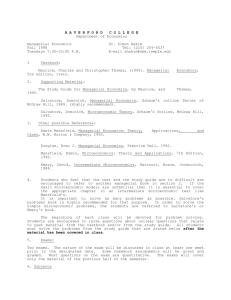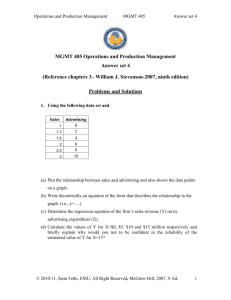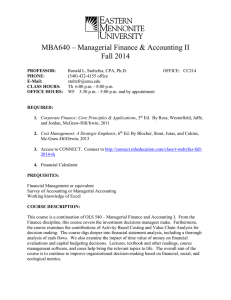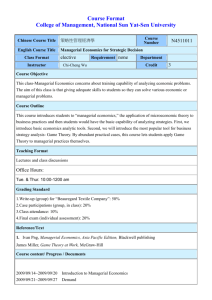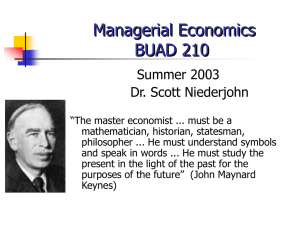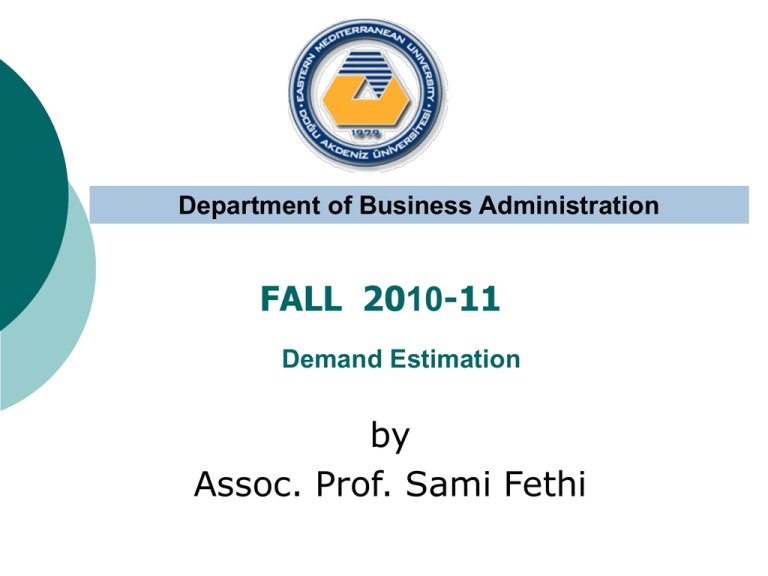
Department of Business Administration
FALL 2010-11
Demand Estimation
by
Assoc. Prof. Sami Fethi
Ch 4 : Demand Estimation
Demand Estimation
To use these important demand relationship in
decision analysis, we need empirically to
estimate the structural form and parameters of
the demand function-Demand Estimation.
Qdx= (P, I, Pc, Ps, T)
(-, + , - , +, +)
The demand for a commodity arises from the consumers’
willingness and ability to purchase the commodity.
Consumer demand theory postulates that the quantity
demanded of a commodity is a function of or depends on the
price of the commodity, the consumers’ income, the price of
related commodities, and the tastes of the consumer.
2
© 2004, Managerial Economics, Dominick Salvatore
© 2010/11, Sami Fethi, EMU, All Right Reserved.
Ch 4 : Demand Estimation
Demand Estimation
In general, we will seek the answer for the
following qustions:
How much will the revenue of the firm change
after increasing the price of the commodity?
How much will the quantity demanded of the
commodity increase if consumers’ income
increase
What if the firms double its ads expenditure?
What if the competitors lower their prices?
Firms should know the answers the
abovementioned questions if they want to
achieve the objective of maximizing thier value.
3
© 2004, Managerial Economics, Dominick Salvatore
© 2010/11, Sami Fethi, EMU, All Right Reserved.
Ch 4 : Demand Estimation
The Identification Problem
The demand curve for a commodity is generally
estimated from market data on the quantity purchased
of the commodity at various price over time (i.e. Timeseries data) or various consuming units at one point in
time (i.e. Cross-sectional data).
Simply joinning priced-quantity observations on a graph
does not generate the demand curve for a commodity.
The reason is that each priced-quantity observation is
given by the intersection of a different and unobserved
demand and supply curve of commodity.
In other words, The difficulty of deriving the demand
curve for a commodity from observed priced-quantity
points that results from the intersection of different and
unobserved demand and supply curves for the
commodity is referred to as the identification
4
problem.
© 2004, Managerial Economics, Dominick Salvatore
© 2010/11, Sami Fethi, EMU, All Right Reserved.
The Identification Problem
© 2004, Managerial Economics, Dominick Salvatore
Ch 4 : Demand Estimation
In the following demand
curve, Observed price-quantity
data points E1, E2, E3, and E4,
result respectively from the
intersection of unobserved
demand and supply curves D1
and S1, D2 and S2, D3 and S3,
and D4 and S4. Therefore, the
dashed
line
connecting
observed points E1, E2, E3, and
E4 is not the demanded curve
for the commodity. The
derived a demand curve for the
commodity, say, D2, we allow
the supply to shift or to be
different and correct, through
regression analysis, for the
forces that cause demand
curve D2 to shift or to be
different as can be seen at
points E2, E'2. This is done by
5
regression analysis.
© 2010/11, Sami Fethi, EMU, All Right Reserved.
Ch 4 : Demand Estimation
Demand Estimation: Marketing Research Approaches
Consumer Surveys
Observational Research
Consumer Clinics
Market Experiments
These approaches are usually covered
extensively
in
marketing
courses,
however the most important of these
are consumer surveys and market
experiments.
6
© 2004, Managerial Economics, Dominick Salvatore
© 2010/11, Sami Fethi, EMU, All Right Reserved.
Ch 4 : Demand Estimation
Demand Estimation: Marketing Research Approaches
o
Consumer surveys: These surveys require the
questioning of a firm’s customers in an
attempt to estimate the relationship between
the demand for its products and a variety of
variables perceived to be for the marketing
and profit planning functions.
These surveys can be conducted by simply
stopping and questioning people at shopping
centre or by administering sophisticated
questionnaires to a carefully constructed
representative sample of consumers by
trained interviewers.
7
© 2004, Managerial Economics, Dominick Salvatore
© 2010/11, Sami Fethi, EMU, All Right Reserved.
Ch 4 : Demand Estimation
Demand Estimation: Marketing Research Approaches
Major advantages: they may provide the
only information available; they can be
made as simple as possible; the researcher
can ask exactly the questions they want
Major disadvantages: consumers may be
unable or unwilling to provide reliable
answers; careful and extensive surveys can
be very expensive.
8
© 2004, Managerial Economics, Dominick Salvatore
© 2010/11, Sami Fethi, EMU, All Right Reserved.
Ch 4 : Demand Estimation
Demand Estimation: Marketing Research Approaches
Market experiments: attempts by the
firm to estimate the demand for the
commodity by changing price and
other determinants of the demand for
the commodity in the actual market
place.
9
© 2004, Managerial Economics, Dominick Salvatore
© 2010/11, Sami Fethi, EMU, All Right Reserved.
Ch 4 : Demand Estimation
Demand Estimation: Marketing Research Approaches
Major advantages: consumers are in a real
market situation; they do not know that they
being observed; they can be conducted on a
large scale to ensure the validity of results.
Major disadvantages: in order to keep cost
down, the experiment may be too limited so the
outcome can be questionable; competitors
could try to sabotage the experiment by
changing prices and other determinants of
demand under their control; competitors can
monitor the experiment to gain very useful
information about the firm would prefer not to
10
disclose.
© 2004, Managerial Economics, Dominick Salvatore
© 2010/11, Sami Fethi, EMU, All Right Reserved.
Ch 4 : Demand Estimation
Purpose of Regression Analysis
Regression Analysis is Used Primarily
to Model Causality and Provide
Prediction
Predict the values of a dependent
(response) variable based on values of at
least one independent (explanatory)
variable
Explain the effect of the independent
variables on the dependent variable
The relationship between X and Y can be
shown on a scatter diagram
11
© 2004, Managerial Economics, Dominick Salvatore
© 2010/11, Sami Fethi, EMU, All Right Reserved.
Ch 4 : Demand Estimation
Scatter Diagram
It is two dimensional graph of plotted points in
which the vertical axis represents values of the
dependent variable and the horizontal axis
represents values of the independent or
explanatory variable.
The patterns of the intersecting points of
variables can graphically show relationship
patterns.
Mostly, scatter diagram is used to prove or
disprove cause-and-effect relationship. In the
following example, it shows the relationship
between advertising expenditure and its sales
revenues.
12
© 2004, Managerial Economics, Dominick Salvatore
© 2010/11, Sami Fethi, EMU, All Right Reserved.
Ch 4 : Demand Estimation
Scatter Diagram-Example
Year
X
Y
1
10
44
2
9
40
3
11
42
4
12
46
5
11
48
6
12
52
7
13
54
8
13
58
9
14
56
10
15
60
Managerial Economics
Scatter Diagram
13
© 2008/09, Sami Fethi, EMU, All Right Reserved.
Ch 4 : Demand Estimation
Scatter Diagram
Scatter diagram
shows a positive
relationship between
the relevant variables.
The relationship is
approximately linear.
This gives us a rough
estimates of the linear
relationship between
the variables in the
form of an equation
such as
Y= a+ b X
14
© 2004, Managerial Economics, Dominick Salvatore
© 2010/11, Sami Fethi, EMU, All Right Reserved.
Ch 4 : Demand Estimation
Regression Analysis
In the equation, a is the vertical
intercept
of
the
estimated
linear
relationship and gives the value of Y
when X=0, while b is the slope of the line
and gives an estimate of the increase in
Y resulting from each unit increase in X.
The difficulty with the scatter diagram is
that different researchers would probably
obtain different results, even if they use
same data points. Solution for this is to
use regression analysis.
15
© 2004, Managerial Economics, Dominick Salvatore
© 2010/11, Sami Fethi, EMU, All Right Reserved.
Ch 4 : Demand Estimation
Regression Analysis
Regression analysis: is a statistical
technique for obtaining the line that best
fits the data points so that all researchers
can reach the same results.
Regression Line: Line of Best Fit
Regression Line: Minimizes the sum of the
squared vertical deviations (et) of each
point from the regression line.
This is the method called Ordinary Least
Squares (OLS).
16
© 2004, Managerial Economics, Dominick Salvatore
© 2010/11, Sami Fethi, EMU, All Right Reserved.
Ch 4 : Demand Estimation
Regression Analysis
Year
X
Y
1
10
44
2
9
40
3
11
42
4
12
46
5
11
48
6
12
52
7
13
54
8
13
58
9
14
56
10
15
60
In the table, Y1 refers actual or observed
sales revenue of $44 mn associated with
the advertising expenditure of $10 mn in
the first year for which data collected.
In the following graph, Y^1 is the
corresponding sales revenue of the firm
estimated from the regression line for the
advertising expenditure of $10 mn in the
first year.
The symbol e1 is the corresponding
vertical deviation or error of the actual
sales revenue estimated from the
regression line in the first year. This can
be expressed as e1= Y1- Y^1.
17
© 2004, Managerial Economics, Dominick Salvatore
© 2010/11, Sami Fethi, EMU, All Right Reserved.
Ch 4 : Demand Estimation
Regression Analysis
In the graph, Y^1 is
the
corresponding
sales revenue of the
firm estimated from
the regression line
for the advertising
expenditure of $10
mn in the first year.
The symbol e1 is the
corresponding
vertical deviation or
error of the actual
sales
revenue
estimated from the
regression line in
the first year. This
can be expressed as
e1= Y1- Y^1.
18
© 2004, Managerial Economics, Dominick Salvatore
© 2010/11, Sami Fethi, EMU, All Right Reserved.
Ch 4 : Demand Estimation
Regression Analysis
Since there are 10
observation points, we
have
obviously
10
vertical deviations or
error (i.e., e1 to e10).
The
regression
line
obtained is the line that
best fits the data points
in the sense that the
sum of the squared
(vertical)
deviations
from
the
line
is
minimum. This means
that each of the 10 e
values is first squared
and then summed.
© 2004, Managerial Economics, Dominick Salvatore
19
© 2010/11, Sami Fethi, EMU, All Right Reserved.
Ch 4 : Demand Estimation
Simple Regression Analysis
Now we are in a position to calculate
the value of a ( the vertical intercept)
and the value of b (the slope
coefficient) of the regression line.
Conduct tests of significance of
parameter estimates.
Construct confidence interval for the
true parameter.
Test for the overall explanatory power
of the regression.
20
© 2004, Managerial Economics, Dominick Salvatore
© 2010/11, Sami Fethi, EMU, All Right Reserved.
Ch 4 : Demand Estimation
Simple Linear Regression Model
Regression line is a straight line that describes
the dependence of the average value of one
variable on the other
Slope
Coefficient
Y Intercept
Random Error
Yi X i i
Dependent
(Response)
Variable
Regression
Line
Independent
(Explanatory)
Variable
21
© 2004, Managerial Economics, Dominick Salvatore
© 2010/11, Sami Fethi, EMU, All Right Reserved.
Ch 4 : Demand Estimation
Ordinary Least Squares (OLS)
Model:
Yt a bX t et
ˆ
Yˆt aˆ bX
t
et Yt Yˆt
22
© 2004, Managerial Economics, Dominick Salvatore
© 2010/11, Sami Fethi, EMU, All Right Reserved.
Ch 4 : Demand Estimation
Ordinary Least Squares (OLS)
Objective: Determine the slope and
intercept that minimize the sum of
the squared errors.
n
n
n
t 1
t 1
t 1
2
2
ˆ )2
ˆ
ˆ
e
(
Y
Y
)
(
Y
a
bX
t t t t
t
23
© 2004, Managerial Economics, Dominick Salvatore
© 2010/11, Sami Fethi, EMU, All Right Reserved.
Ch 4 : Demand Estimation
Ordinary Least Squares (OLS)
Estimation Procedure
n
bˆ
(X
t 1
t
X )(Yt Y )
n
2
(
X
X
)
t
ˆ
â Y bX
t 1
24
© 2004, Managerial Economics, Dominick Salvatore
© 2010/11, Sami Fethi, EMU, All Right Reserved.
Ordinary Least Squares (OLS)
Ch 4 : Demand Estimation
Estimation Example
Time
Xt
Yt
Xt X
Yt Y
( X t X )(Yt Y )
( X t X )2
1
2
3
4
5
6
7
8
9
10
10
9
11
12
11
12
13
13
14
15
120
44
40
42
46
48
52
54
58
56
60
500
-2
-3
-1
0
-1
0
1
1
2
3
-6
-10
-8
-4
-2
2
4
8
6
10
12
30
8
0
2
0
4
8
12
30
106
4
9
1
0
1
0
1
1
4
9
30
n 10
n
X
t 1
n
X 120
X t 12
10
t 1 n
t
120
n
n
(X
Yt 500
t 1
t 1
n
Y 500
Y t
50
10
t 1 n
© 2004, Managerial Economics, Dominick Salvatore
n
(X
t 1
t
t
X ) 2 30
X )(Yt Y ) 106
106
bˆ
3.533
30
aˆ 50 (3.533)(12) 7.60
25
© 2010/11, Sami Fethi, EMU, All Right Reserved.
Ch 4 : Demand Estimation
Ordinary Least Squares (OLS)
Estimation Example
n
X t 120
X
12
10
t 1 n
n 10
n
X t 120
t 1
n
(X
t 1
t 1
Y
t 1
t
500
n
Yt 500
Y
50
10
t 1 n
t
X ) 30
106
bˆ
3.533
30
t
X )(Yt Y ) 106
aˆ 50 (3.533)(12) 7.60
2
n
(X
n
© 2004, Managerial Economics, Dominick Salvatore
26
© 2010/11, Sami Fethi, EMU, All Right Reserved.
Ch 4 : Demand Estimation
The Equation of Regression Line
The equation of the regression line can be
constructed as follows:
Yt^=7.60 +3.53 Xt
When X=0 (zero advertising expenditures),
the expected sales revenue of the firm is
$7.60 mn. In the first year, when X=10mn,
Y1^= $42.90 mn.
Strictly speaking, the regression line should be
used only to estimate the sales revenues
resulting from advertising expenditure that are
within the range.
27
© 2004, Managerial Economics, Dominick Salvatore
© 2010/11, Sami Fethi, EMU, All Right Reserved.
Ch 4 : Demand Estimation
Crucial Assumptions
Error term is normally distributed.
Error term has zero expected value
or mean.
Error term has constant variance in
each time period and for all values
of X.
Error term’s value in one time
period is unrelated to its value in
any other period.
28
© 2004, Managerial Economics, Dominick Salvatore
© 2010/11, Sami Fethi, EMU, All Right Reserved.
Ch 4 : Demand Estimation
Tests of Significance: Standard Error
To test the hypothesis that b is
statistically
significant
(i.e.,
advertising positively affects sales),
we need first of all to calculate
standard error (deviation) of b^.
The
standard
error
can
be
calculated
in
the
following
expression:
29
© 2004, Managerial Economics, Dominick Salvatore
© 2010/11, Sami Fethi, EMU, All Right Reserved.
Ch 4 : Demand Estimation
Tests of Significance
Standard Error of the Slope Estimate
sbˆ
2
ˆ
(Yt Y )
( n k ) ( X t X )
2
e
(n k ) ( X
2
t
t
X )2
30
© 2004, Managerial Economics, Dominick Salvatore
© 2010/11, Sami Fethi, EMU, All Right Reserved.
Tests of Significance
Ch 4 : Demand Estimation
Example Calculation
Time
Xt
Yt
Yˆt
et Yt Yˆt
et2 (Yt Yˆt )2
( X t X )2
1
10
44
42.90
1.10
1.2100
4
2
9
40
39.37
0.63
0.3969
9
3
11
42
46.43
-4.43
19.6249
1
4
12
46
49.96
-3.96
15.6816
0
5
11
48
46.43
1.57
2.4649
1
6
12
52
49.96
2.04
4.1616
0
7
13
54
53.49
0.51
0.2601
1
8
13
58
53.49
4.51
20.3401
1
9
14
56
57.02
-1.02
1.0404
4
10
15
60
60.55
-0.55
0.3025
9
65.4830
30
(Y Yˆ )
( n k ) ( X X )
2
sbˆ
t
t
2
65.4830
0.52
(10 2)(30)
n
n
e (Yt Yˆt )2 65.4830
t 1
2
t
t 1
Yt^=7.60 +3.53 Xt =7.60+3.53(10)= 42.90
© 2004, Managerial Economics, Dominick Salvatore
n
(X
t 1
t
X ) 2 30
31
© 2010/11, Sami Fethi, EMU, All Right Reserved.
Ch 4 : Demand Estimation
Tests of Significance
Example Calculation
n
n
t 1
t 1
2
2
ˆ
e
(
Y
Y
)
t t t 65.4830
n
2
(
X
X
)
30
t
t 1
2
ˆ
(Yt Y )
65.4830
sbˆ
0.52
2
( n k ) ( X t X )
(10 2)(30)
32
© 2004, Managerial Economics, Dominick Salvatore
© 2010/11, Sami Fethi, EMU, All Right Reserved.
Ch 4 : Demand Estimation
Tests of Significance
Calculation of the t Statistic
bˆ 3.53
t
6.79
sbˆ 0.52
Degrees of Freedom = (n-k) = (10-2) = 8
Critical Value (tabulated) at 5% level =2.306
33
© 2004, Managerial Economics, Dominick Salvatore
© 2010/11, Sami Fethi, EMU, All Right Reserved.
Ch 4 : Demand Estimation
Confidence interval
We can also construct confidence interval
for the true parameter from the estimated
coefficient.
Accepting the alternative hypothesis that
there is a relationship between X and Y.
Using tabular value of t=2.306 for 5% and
8 df in our example, the true value of b will
lies between 2.33 and 4.73
t=b^+/- 2.306 (sb^)=3.53+/- 2.036 (0.52)
34
© 2004, Managerial Economics, Dominick Salvatore
© 2010/11, Sami Fethi, EMU, All Right Reserved.
Ch 4 : Demand Estimation
Tests of Significance
Decomposition of Sum of Squares
Total Variation = Explained Variation + Unexplained Variation
2
2
ˆ
ˆ
(Yt Y ) (Y Y ) (Yt Yt )
2
35
© 2004, Managerial Economics, Dominick Salvatore
© 2010/11, Sami Fethi, EMU, All Right Reserved.
Ch 4 : Demand Estimation
Tests of Significance
Decomposition of Sum of Squares
36
© 2004, Managerial Economics, Dominick Salvatore
© 2010/11, Sami Fethi, EMU, All Right Reserved.
Ch 4 : Demand Estimation
Coefficient of Determination
Coefficient of Determination: is defined
as the proportion of the total variation
or dispersion in the dependent variable
that explained by the variation in the
explanatory variables in the regression.
In our example, COD measures how
much of the variation in the firm’s sales
is explained by the variation in its
advertising expenditures.
37
© 2004, Managerial Economics, Dominick Salvatore
© 2010/11, Sami Fethi, EMU, All Right Reserved.
Ch 4 : Demand Estimation
Tests of Significance
Coefficient of Determination
2
ˆ
(Y Y )
Explained Variation
R
2
TotalVariation
(
Y
Y
)
t
2
373.84
R
0.85
440.00
2
38
© 2004, Managerial Economics, Dominick Salvatore
© 2010/11, Sami Fethi, EMU, All Right Reserved.
Ch 4 : Demand Estimation
Coefficient of Correlation
Coefficient of Correlation (r): The
square root of the coefficient of
determination.
This is simply a measure of the degree
of association or co-variation that
exists between variables X and Y.
In our example, this mean that
variables X and Y vary together 92%
of the time.
The sign of coefficient r is always the
same as the sign of coefficient of b^.
© 2004, Managerial Economics, Dominick Salvatore
39
© 2010/11, Sami Fethi, EMU, All Right Reserved.
Ch 4 : Demand Estimation
Tests of Significance
Coefficient of Correlation
r R 2 withthe sign of bˆ
1 r 1
r 0.85 0.92
40
© 2004, Managerial Economics, Dominick Salvatore
© 2010/11, Sami Fethi, EMU, All Right Reserved.
Ch 4 : Demand Estimation
Multiple Regression Analysis
Model:
Y a b1 X1 b2 X 2 bk ' X k '
41
© 2004, Managerial Economics, Dominick Salvatore
© 2010/11, Sami Fethi, EMU, All Right Reserved.
Ch 4 : Demand Estimation
Multiple Regression Analysis
Relationship between 1 dependent & 2 or more
independent variables is a linear function
Y-intercept
Slopes
Random error
Yi X1i X 2i
k X ki i
Dependent (Response) variable
Independent (Explanatory) variables
© 2004, Managerial Economics, Dominick Salvatore
42
© 2010/11, Sami Fethi, EMU, All Right Reserved.
Ch 4 : Demand Estimation
Multiple Regression Analysis
Yi = 0 + 1X1i + 2X2i + i
Y
Response
Plane
X1
(Observed Y)
0
i
X2
(X1i,X2i)
Y|X = 0 + 1X1i + 2X2i
43
© 2004, Managerial Economics, Dominick Salvatore
© 2010/11, Sami Fethi, EMU, All Right Reserved.
Ch 4 : Demand Estimation
Multiple Regression Analysis
Too
complicated
by hand!
Ouch!
44
© 2004, Managerial Economics, Dominick Salvatore
© 2010/11, Sami Fethi, EMU, All Right Reserved.
Ch 4 : Demand Estimation
Multiple Regression Model: Example
Develop a model for estimating
heating oil used for a single family
home in the month of January,
based on average temperature and
amount of insulation in inches.
Oil (Gal) Temp
Insulation
275.30
40
3
363.80
27
3
164.30
40
10
40.80
73
6
94.30
64
6
230.90
34
6
366.70
9
6
300.60
8
10
237.80
23
10
121.40
63
3
31.40
65
10
203.50
41
6
441.10
21
3
323.00
38
3
52.50
58
10
45
© 2004, Managerial Economics, Dominick Salvatore
© 2010/11, Sami Fethi, EMU, All Right Reserved.
Ch 4 : Demand Estimation
Multiple Regression Model: Example
Yˆi b0 b1 X1i b2 X 2i
Excel Output
Intercept
X Variable 1
X Variable 2
bk X ki
Coefficients
562.1510092
-5.436580588
-20.01232067
Yˆi 562.151 5.437 X1i 20.012 X 2i
For each degree increase in
temperature, the estimated
average amount of heating oil
used is decreased by 5.437
gallons, holding insulation
constant.
© 2004, Managerial Economics, Dominick Salvatore
For each increase in one inch of
insulation, the estimated average use
of heating oil is decreased by 20.012
gallons,
holding
temperature
constant.
46
© 2010/11, Sami Fethi, EMU, All Right Reserved.
Ch 4 : Demand Estimation
Multiple Regression Analysis
Adjusted Coefficient of Determination
(n 1)
R 1 (1 R )
(n k )
2
2
rY2,12
R e g re ssi o n S ta ti sti c s
M u lt ip le R
0.982654757
R S q u a re
0.965610371
A d ju s t e d R S q u a re
0.959878766
S t a n d a rd E rro r
26.01378323
O b s e rva t io n s
SSR
SST
15
47
© 2004, Managerial Economics, Dominick Salvatore
© 2010/11, Sami Fethi, EMU, All Right Reserved.
Ch 4 : Demand Estimation
Interpretation of Coefficient of Multiple Determination
96.56% of the total variation
in heating oil can be explained
by temperature and amount
of insulation
2
Y 12
r
SSR
.9656
SST
95.99% of the total fluctuation
in heating oil can be explained
by temperature and amount of
insulation after adjusting for
the number of explanatory
variables and sample size
2
radj
.9599
48
© 2004, Managerial Economics, Dominick Salvatore
© 2010/11, Sami Fethi, EMU, All Right Reserved.
Ch 4 : Demand Estimation
Testing for Overall Significance
Shows if Y Depends Linearly on All of the X
Variables Together as a Group
Use F Test Statistic
Hypotheses:
H0: … k = 0 (No linear relationship)
H1: At least one i ( At least one independent
variable affects Y )
The Null Hypothesis is a Very Strong Statement
The Null Hypothesis is Almost Always Rejected
49
© 2004, Managerial Economics, Dominick Salvatore
© 2010/11, Sami Fethi, EMU, All Right Reserved.
Ch 4 : Demand Estimation
Multiple Regression Analysis
Analysis of Variance and F Statistic
Explained Variation /(k 1)
F
Unexplained Variation /(n k )
R /(k 1)
F
2
(1 R ) /(n k )
2
50
© 2004, Managerial Economics, Dominick Salvatore
© 2010/11, Sami Fethi, EMU, All Right Reserved.
Ch 4 : Demand Estimation
k = 3, no of
parameters
Test for Overall Significance
Excel Output: Example
ANOVA
df
Regression
Residual
Total
k -1= 2, the number
SS
MS
F
Significance F
2 228014.6 114007.3 168.4712
1.65411E-09
12 8120.603 676.7169
14 236135.2
n-1
p-value
of explanatory
variables and
dependent variable
51
© 2004, Managerial Economics, Dominick Salvatore
© 2010/11, Sami Fethi, EMU, All Right Reserved.
Ch 4 : Demand Estimation
Test for Overall Significance:
Example Solution
H0: 1 = 2 = … = k = 0
Test Statistic:
H1: At least one j 0
= .05
F
168.47
df = 2 and 12
Critical Value:
= 0.05
0
3.89
© 2004, Managerial Economics, Dominick Salvatore
Decision:
Reject at = 0.05.
Conclusion:
There is evidence that at
least one independent
variable affects Y.
52
© 2010/11, Sami Fethi, EMU, All Right Reserved.
Ch 4 : Demand Estimation
t Test Statistic
Excel Output: Example
t Test Statistic for X1
(Temperature)
Coefficients Standard Error
t Stat
Intercept
562.1510092
21.09310433 26.65094
Temp
-5.436580588
0.336216167 -16.1699
Insulation -20.01232067
2.342505227 -8.543127
bi
t
Sbi
P-value
4.77868E-12
1.64178E-09
1.90731E-06
t Test Statistic for X2
(Insulation)
53
© 2004, Managerial Economics, Dominick Salvatore
© 2010/11, Sami Fethi, EMU, All Right Reserved.
Ch 4 : Demand Estimation
t Test : Example Solution
Does temperature have a significant effect on monthly
consumption of heating oil? Test at = 0.05.
Test Statistic:
H0: 1 = 0
t Test Statistic = -16.1699
H1: 1 0
Decision:
df = 12
Reject H0 at = 0.05.
Critical Values:
Reject H 0 There is evidence of a significant
Reject H 0
.025
-2.1788
Conclusion:
.025
0
2.1788
© 2004, Managerial Economics, Dominick Salvatore
effect of temperature on oil
consumption holding constant the
effect of insulation.
54
© 2010/11, Sami Fethi, EMU, All Right Reserved.
Ch 4 : Demand Estimation
Problems in Regression Analysis
Multicollinearity: Two or more explanatory
variables are highly correlated.
Heteroskedasticity: Variance of error term is not
independent of the Y variable.
Autocorrelation: Consecutive error terms are
correlated.
Functional form: Misspecified by the omission of
a variable
Normality: Residuals are normally distributed or
not
55
© 2004, Managerial Economics, Dominick Salvatore
© 2010/11, Sami Fethi, EMU, All Right Reserved.
Ch 4 : Demand Estimation
Practical Consequences of Multicollinearity
Large variance or standard error
Wider confidence intervals
Insignificant t-ratios
A high R2 value but few significant tratios
OLS estimators and their Std. Errors
tend to be unstable
Wrong signs for regression coefficients
56
© 2004, Managerial Economics, Dominick Salvatore
© 2010/11, Sami Fethi, EMU, All Right Reserved.
Ch 4 : Demand Estimation
Multicollinearity
How can Multicollinearity be overcome?
Increasing number of observation
Acquiring additional data
A new sample
Using an experience from a previous study
Transformation of the variables
Dropping a variable from the model
This is the simplest solution, but the worse
one referring an economic model (i.e., model
specification error)
57
© 2004, Managerial Economics, Dominick Salvatore
© 2010/11, Sami Fethi, EMU, All Right Reserved.
Ch 4 : Demand Estimation
Heteroskedasticity
Heteroskedasticity: Variance of error term is
not independent of the Y variable or
unequal/non-constant variance. This means
that when both response and explanatory
variables increase, the variance of response
variables does not remain same at all levels of
explanatory variables (cross-sectional data).
Homoscedasticity: when both response and
explanatory variables increase, the variance of
response variable
around its mean value
remains same at all levels of explanatory
variables (equal variance).
58
© 2004, Managerial Economics, Dominick Salvatore
© 2010/11, Sami Fethi, EMU, All Right Reserved.
Ch 4 : Demand Estimation
Residual Analysis for Homoscedasticity
Y
Y
X
SR
X
SR
X
Heteroscedasticity
© 2004, Managerial Economics, Dominick Salvatore
X
Homoscedasticity
59
© 2010/11, Sami Fethi, EMU, All Right Reserved.
Ch 4 : Demand Estimation
Autocorrelation or serial correlation
Autocorrelation: Correlation between
members of observation ordered in
time as in time series data (i.e.,
residuals
are
correlated
where
consecutive errors have the same
sign).
Detecting Autocorrelation: This can be
detected by many ways. The most
common used is DW statistics.
60
© 2004, Managerial Economics, Dominick Salvatore
© 2010/11, Sami Fethi, EMU, All Right Reserved.
Ch 4 : Demand Estimation
Durbin-Watson Statistic
Test for Autocorrelation
n
d
2
(
e
e
)
t t 1
t 2
n
2
e
t
t 1
If d=2, autocorrelation is absent.
61
© 2004, Managerial Economics, Dominick Salvatore
© 2010/11, Sami Fethi, EMU, All Right Reserved.
Ch 4 : Demand Estimation
Residual Analysis for Independence
The Durbin-Watson Statistic
– Used when data is collected over time to detect
autocorrelation (residuals in one time period are
related to residuals in another period)
– Measures violation of independence assumption
n
D
2
(
e
e
)
i i1
i 2
n
e
i 1
2
i
Should be close to 2.
If not, examine the model
for autocorrelation.
62
© 2004, Managerial Economics, Dominick Salvatore
© 2010/11, Sami Fethi, EMU, All Right Reserved.
Ch 4 : Demand Estimation
Residual Analysis for Independence
Graphical Approach
Not Independent
e
Independent
e
Time
Cyclical Pattern
Time
No Particular Pattern
Residual is Plotted Against Time to Detect Any Autocorrelation
63
© 2004, Managerial Economics, Dominick Salvatore
© 2010/11, Sami Fethi, EMU, All Right Reserved.
Ch 4 : Demand Estimation
Using the Durbin-Watson Statistic
H0
: No autocorrelation (error terms are independent)
H1
: There is autocorrelation (error terms are not)
Reject H0
(positive
autocorrelation)
0
dL
Inconclusive
Accept H0
(no autocorrelation)
dU
© 2004, Managerial Economics, Dominick Salvatore
2
4-dU
Reject H0
(negative
autocorrelation)
4-dL
4
64
© 2010/11, Sami Fethi, EMU, All Right Reserved.
Ch 4 : Demand Estimation
Steps in Demand Estimation
Model Specification: Identify Variables
Collect Data
Specify Functional Form
Estimate Function
Test the Results
65
© 2004, Managerial Economics, Dominick Salvatore
© 2010/11, Sami Fethi, EMU, All Right Reserved.
Ch 4 : Demand Estimation
Functional Form Specifications
Linear Function:
QX a0 a1PX a2 I a3 N a4 PY
Power Function:
QX a( PXb1 )( PYb2 )
e
Estimation Format:
ln QX ln a b1 ln PX b2 ln PY
66
© 2004, Managerial Economics, Dominick Salvatore
© 2010/11, Sami Fethi, EMU, All Right Reserved.
Ch 4 : Demand Estimation
Dummy-Variable Models
When the explanatory variables are
qualitative in nature, these are known
as dummy variables. These can also
defined as indicators variables, binary
variables, categorical variables, and
dichotomous
variables
such
as
variable D in the following equation:
Q x c 0 c1 Px c 2 I c3 D ...... e
67
© 2004, Managerial Economics, Dominick Salvatore
© 2010/11, Sami Fethi, EMU, All Right Reserved.
Ch 4 : Demand Estimation
Dummy-Variable Models
Categorical Explanatory Variable with 2 or More Levels
Yes or No, On or Off, Male or Female,
Use Dummy-Variables (Coded as 0 or 1)
Only Intercepts are Different
Assumes Equal Slopes Across Categories
Regression Model Has Same Form
Can the dependent variable be dummy?
68
© 2004, Managerial Economics, Dominick Salvatore
© 2010/11, Sami Fethi, EMU, All Right Reserved.
Ch 4 : Demand Estimation
Dummy-Variable Models
Given:
Yˆi b0 b1 X1i b2 X 2i
Y = Assessed Value of House
X1 = Square Footage of House
X2 = Desirability of Neighbourhood =
0 if undesirable
1 if desirable
Desirable (X2 = 1)
Yˆi b0 b1 X1i b2 (1) (b0 b2 ) b1 X1i
Undesirable (X2 = 0)
Yˆi b0 b1 X1i b2 (0) b0 b1 X1i
Same
slopes
69
© 2004, Managerial Economics, Dominick Salvatore
© 2010/11, Sami Fethi, EMU, All Right Reserved.
Ch 4 : Demand Estimation
Simple and Multiple Regression Compared: Example
70
© 2004, Managerial Economics, Dominick Salvatore
© 2010/11, Sami Fethi, EMU, All Right Reserved.
Ch 4 : Demand Estimation
71
© 2004, Managerial Economics, Dominick Salvatore
© 2010/11, Sami Fethi, EMU, All Right Reserved.
Ch 4 : Demand Estimation
72
© 2004, Managerial Economics, Dominick Salvatore
© 2010/11, Sami Fethi, EMU, All Right Reserved.
Ch 4 : Demand Estimation
73
© 2004, Managerial Economics, Dominick Salvatore
© 2010/11, Sami Fethi, EMU, All Right Reserved.
Ch 4 : Demand Estimation
Regression Analysis in Practice
Suppose we have an
Employment (Labor
Demand) Function as follows:
N=Constant+K+W+AD+P+WT
N: employees in employment
K: capital accumulation
W: value of real wages
AD: aggregate deficit
P: effect of world manufacturing exports on
employment
WT: the deviation of world trade from trend.
74
© 2004, Managerial Economics, Dominick Salvatore
© 2010/11, Sami Fethi, EMU, All Right Reserved.
Ch 4 : Demand Estimation
Output by Microfit v4.0w
Ordinary Least Squares Estimation
*******************************************************************************
Dependent variable is LOGN
39 observations used for estimation from 1956 to 1994
*******************************************************************************
Regressor
Coefficient
Standard Error
T-Ratio[Prob]
CON
4.9921
.98407
5.0729[.000]
LOGK
.040394
.012998
3.1078[.004]
LOGW
.024737
.010982
2.2526[.032]
AD
-.9174E-7
.1587E-6
.57798[.567]
LOGP
.026977
.0099796
2.7032[.011]
LOGWT
-.053944
.024279
2.2219[.034]
*******************************************************************************
R-Squared
.82476
F-statistic F( 6, 33)
20.8432[.000]
R-Bar-Squared
.78519
S.E. of Regression
.012467
Residual Sum of Squares
.0048181
Mean of Dependent Variable
10.0098
S.D. of Dependent Variable
.026899
Maximum of Log-likelihood
120.1407
DW-statistic
1.8538
*******************************************************************************
75
© 2004, Managerial Economics, Dominick Salvatore
© 2010/11, Sami Fethi, EMU, All Right Reserved.
Ch 4 : Demand Estimation
Diagnostic Tests
******************************************************************************
*
*
Test Statistics
*
LM Version
*
F Version
*
******************************************************************************
*
*
*
*
*
* A:Serial Correlation *CHI-SQ( 1)= .051656[.820]*F(1,30)=.039788[.843]*
*
*
*
*
* B:Functional Form
*CHI-SQ( 1)= .056872[.812]*F(1,30)=.043812[.836]*
*
*
*
*
* C:Normality
*CHI-SQ( 2)=
1.2819[.527]*
Not applicable
*
*
*
*
*
* D:Heteroscedasticity *CHI-SQ( 1)=
1.0065[.316]*F( 1,37)=.98022[.329]*
******************************************************************************
*
A:Lagrange
B:Ramsey's
C:Based on
D:Based on
multiplier test of residual serial correlation
RESET test using the square of the fitted values
a test of skewness and kurtosis of residuals
the regression of squared residuals on squared fitted values
76
© 2004, Managerial Economics, Dominick Salvatore
© 2010/11, Sami Fethi, EMU, All Right Reserved.
Ch 4 : Demand Estimation
Dependent Variable: LOGN
Explanatory Variables
CON
LOGK
LOGW
AD
LOGP
LOGWT
R2 bar
R2
4.9921
(5.07)
0.40394
(3.10)
0.0247
(2.25)
-0.9174
(-0.577)
0.0269
(2.70)
-0.0539
(-2.22)
0.87
0.83
DW
2.16
SER
0.021
X2SC
.05165[.820]
X2FF
05687[.812]
X2NORM
1.2819[.527]
X2HET
1.0065[.316]
© 2004, Managerial Economics, Dominick Salvatore
77
© 2010/11, Sami Fethi, EMU, All Right Reserved.
Ch 4 : Demand Estimation
Interpretation
t-test (individual significance)
Let’s first see the significance of each
variable;
n=39
k=6 and hence d.f.=39-6=33
=0.05 (our confidence level is 95%).
With =0.05 and d.f.=33, ttab=2.045
Our Hypothesis are:
Ho:s=0 (not significant)
H1: s0 (significant)
This is t- distribution and using this
distribution, you can decide whether
individual t-values (calculated or
estimated) of the existing variables are
significant or not according to the
tabulated t-values as appears in the fig
above.
© 2004, Managerial Economics, Dominick Salvatore
78
© 2010/11, Sami Fethi, EMU, All Right Reserved.
Ch 4 : Demand Estimation
F-test (overall significance)
Our result is F(6,33)=20.8432
k-1=5 and n-k=33
= 0.05 (our confidence level is
95%).
With = 0.05 and F(6,33), the
Ftab=2.34
Our hypothesis are
Ho:R2s=0 (not significant)
H1: R20 (significant)
79
© 2004, Managerial Economics, Dominick Salvatore
© 2010/11, Sami Fethi, EMU, All Right Reserved.
Ch 4 : Demand Estimation
Diagnostic Tests:
Serial Correlation:
Ho:=0(existence of autocorrelation )
H1:0 (no autocorrelation)
Since
CHI-SQ(1)=0.051656<
X2=3.841, we reject Ho that
estimate regression does not have
first order serial correlation or
autocorrelation.
80
© 2004, Managerial Economics, Dominick Salvatore
© 2010/11, Sami Fethi, EMU, All Right Reserved.
Ch 4 : Demand Estimation
Functional Form:
Ho:=0 (existence misspecification)
H1: 0 (no of misspecification)
The estimated LM version of CHISQ is 0.0568721 and with = 0.05
the tabular value is X2=3.841.
Because CHI-SQ (1)=0.0568721<
X2=3.841, then we reject the null
hypothesis that there is functional
misspecification.
81
© 2004, Managerial Economics, Dominick Salvatore
© 2010/11, Sami Fethi, EMU, All Right Reserved.
Ch 4 : Demand Estimation
Normality:
Ho:ut=0
(residuals
normally distributed)
H1:ut0(residuals are
distributed)
are
not
normally
Our estimated result of LM version
for
normality
is
CHISQ(2)=1.28191, and the tabular
value with 2 restrictions with =
0.05 is X2=5.991.
Since
CHI-SQ(2)=1.28191<
X2=5.991, the test result shows that
the null hypothesis of normality of
the residuals is accepted.
82
© 2004, Managerial Economics, Dominick Salvatore
© 2010/11, Sami Fethi, EMU, All Right Reserved.
Ch 4 : Demand Estimation
Heteroscedasticity:
Ho:yt2=2 (heteroscedasticity)
H1: yt22(homoscedasticity)
LM version of our result for
the heteroscedasticity is CHISQ(1)=1.00651 and table
critical
value
with
1
restriction with = 0.05 is
X2=3.841.
Since
CHISQ(1)=1.00651< X2=3.841,
we accept the null hypothesis
that error term is constant
for
all
the
independent
variables.
© 2004, Managerial Economics, Dominick Salvatore
83
© 2010/11, Sami Fethi, EMU, All Right Reserved.
Ch 4 : Demand Estimation
The End
Thanks
84
© 2004, Managerial Economics, Dominick Salvatore
© 2010/11, Sami Fethi, EMU, All Right Reserved.

